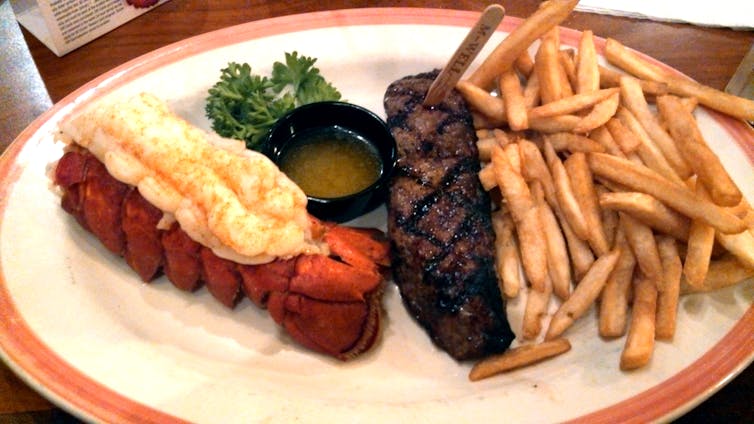Vale Sizzler: the cheese toast king couldn't keep up with dining trends
- Written by Katherine Kirkwood, PhD Candidate, Queensland University of Technology
After 35 years in Australia, the last plates of cheese toast will soon be served at Sizzler’s nine remaining outlets across Queensland, New South Wales and Western Australia.
The family-friendly restaurant, famous for the all-you-can-eat salad bar and cheesy TV ads, was once a suburban dining stalwart. But Sizzler’s closure on 15 November isn’t just another consequence of COVID-19.
Australia’s food values and tastes have changed since the chain’s heyday of the 1990s. Today, food is much more important in our everyday lives.
An era of casual dining
Sizzler began in the United States in the late 1950s, opening its first Australian restaurant in 1985 in the Brisbane suburb of Annerley. A novelty of the chain was its salad bar, which the Canberra Times in 1992 described as:
15 metres of salad choices, two soup choices and croutons and rolls, a potato casserole, savoury rice, two types of pasta (with the usual unfortunate consequences for pasta left sitting) with a meat, tomato and cream sauces, and four or five desserts.
Optional steak, seafood and chicken offerings could be served to your table. When the chain reached its Australian peak in the mid-1990s, our food culture was very different. Cuisine of the era was increasingly multicultural – as food author Cherry Ripe notes in her book Goodbye Culinary Cringe – but food was more often spoken about in utilitarian terms.
Sizzler positioned itself as food that was cheap and fast, but not “fast food”. Most of those who dined there, alongside the dine-in all-you-can eat Pizza Huts, earned under A$60,000 (approximately $110,000 today).
But over the past 25 years, the way Australian families dine has dramatically changed. Instead of a large “family friendly” diner, we are more likely to frequent a range of small, culturally diverse eateries.
The changing face of value
While Sizzler has attributed the shuttering of the final nine stores to the impact of COVID-19, the brand has experienced a slow death, with 19 outlets closing across Australia since 2015.
Its demise can be attributed to many factors.
Since Sizzler’s peak, Australian consumers have shown greater interest in food provenance, or understanding where their food comes from.
There are growing concerns about environmental impacts of the way we eat, particularly around food waste. These concerns become stark in buffet settings.
Other contemporary culinary interests include the ideals of “clean eating” and Instagrammable #foodporn – Sizzler isn’t entirely suited to either category.
 Sizzler’s meals aren’t exactly #foodporn.
Mark James Miller/Wikimedia Commons, CC BY-SA
Sizzler’s meals aren’t exactly #foodporn.
Mark James Miller/Wikimedia Commons, CC BY-SA
Once considered “alternative” approaches to eating, vegetarianism and veganism are also on the rise. By 2019, more than 2.5 million Australians were vegan or vegetarian.
We have embraced movements like flexitarianism (a mostly plant-based diet, with animal products eaten in moderation) and Meat Free Mondays. Sizzler is known for its salad bar, but the prominent grill offerings of steak, seafood and chicken don’t necessarily align with these culinary values.
Pressure has been placed on Sizzler, too, as fast-casual dining chains gain popularity, with companies like Guzman y Gomez and Grill’d focusing on ethical and healthy choices.
The pressures faced by Sizzler can also be seen in the Australian fine-dining sector. There has been an explosion of mid-tier, casual but trendy venues opening to accommodate diners’ changing tastes. This has led to closures of both “value for money” sit-down restaurants, like Sizzler, at one end of the spectrum, and fine dining at the other end.
Our notion of what constitutes “good value” has also evolved.
Until Sunday, a standard Sizzler all-you-can-eat salad bar will cost you $27.95. You can add $4 and get a rump steak, or $2 for a “Malibu Chicken Supreme” (think parmy-meets-Chicken-Cordon-Bleu).
But “value” now lies in the quality rather than quantity of one’s meal. As Australians’ idea of value is shifting, we are inclined to pay more for food we consider to be good quality – so $30 for an average steak and salad now seems rather steep.
This isn’t to say Australians are a bunch of food snobs.
In my 2014 research into food and food media habits, I spoke to then 38-year-old food enthusiast Melanie, who enjoyed trips to Adriano Zumbo’s Sydney patisserie and celebrated her sister’s 40th birthday dinner at Tom Colicchio’s New York restaurant – but she was not opposed to more lowbrow or fast-food offerings.
I will say I love fine dining, but if you offered me up Sizzler on a Sunday, I’m right there.
I hope Melanie got a booking at Sizzler to enjoy one last Sunday indulgence.
Authors: Katherine Kirkwood, PhD Candidate, Queensland University of Technology



